Sarah Sundin's Blog, page 29
January 9, 2025
A Dog, the President’s Son, and a Grieving Sailor
 Sometimes historical research is dry, but often it brings up fascinating stories. While reading excerpts from 1945 issues of Time Magazine, a story grabbed my attention. It involved Antioch, California—the small (at the time) town I used as the hometown for the heroes in my Wings of Glory series. A bit of time over microfiche copies of the Antioch Ledger pulled the details together.
Sometimes historical research is dry, but often it brings up fascinating stories. While reading excerpts from 1945 issues of Time Magazine, a story grabbed my attention. It involved Antioch, California—the small (at the time) town I used as the hometown for the heroes in my Wings of Glory series. A bit of time over microfiche copies of the Antioch Ledger pulled the details together.
Like many good stories, this involves an unlikely assortment of characters.
The President’s Son and a Hollywood Actress
Brig. Gen. Elliott Roosevelt, Commander, 325th Photographic Wing, 1945 (US government photo)
Col. Elliott Roosevelt, second son of President Franklin D. Roosevelt, served in the US Eighth Air Force based in England as a pilot and a commander of a reconnaissance wing. On December 3, 1944, he married glamorous film star Faye Emerson at the Grand Canyon. This was his third marriage.

Publicity still of actress Faye Emerson, 1943 (public domain via Warner Bros. Studio)
A Small-Town Police ChiefIn an entirely different world, Al LeRoy served as police chief in Antioch, California, population 7250. With his wife—also named Faye—he raised two stepsons and his son, Leon. At seventeen, Leon joined the US Navy and was assigned as a gunner on a tanker. Chief Al LeRoy was an upstanding member of the community—a World War I veteran and a member of multiple civic organizations. On December 6, 1944, he died of a heart attack at age 44. At sea, his 18-year-old son Leon was unaware of his father’s death.
A Dog Named BlazeBack in England, Colonel Roosevelt bought a 130-pound bull mastiff named Blaze for his bride, and he had it shipped to her Hollywood home.
A Grieving Sailor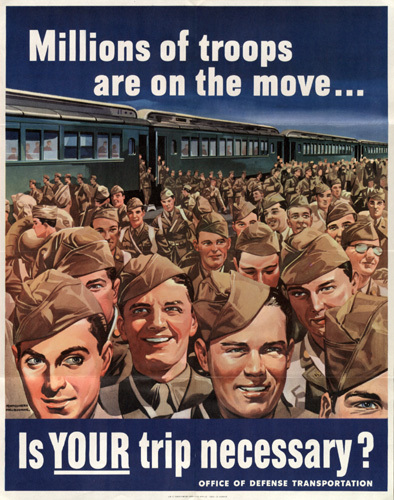
US poster, WWII
On January 4, 1945, Seaman 1/C Leon LeRoy’s ship docked in New York City. There he received a pile of letters—and he finally learned of his father’s death. He received a furlough to go home and visit his mother.
During the war, the transportation system was strained by the competing needs of civilian and military transport. Military travel took priority, but even in the military, priorities were assigned. Seaman LeRoy had “C” priority.
Bumped by a Dog
Douglas C-47 Skytrain of US Air Transport Command, 1940s (US Air Force photo)
On January 9, 1945, the C-47 transport plane carrying Seaman 1/C Leon LeRoy landed in Memphis, Tennessee. Cargo was loaded carrying an “A” priority label, meaning it was “required by an emergency so acute that precedence should be given over all other traffic.” This crucial cargo was a large crate carrying Blaze the bull mastiff. To make room, Seaman LeRoy was bumped from the flight, along with a Seabee and Army T/Sgt. Dave Aks, home for the first time in thirty-one months to visit his critically ill wife in Riverside, California. Hitchhiking part of the way to Antioch, LeRoy wouldn’t arrive until January 16, leaving him only three days to stay at home.
National ScandalThe Antioch Ledger published the story on January 16, 1945. It was picked up by the UP on January 17, and the story made the January 29 issue of Time Magazine. The public was incensed, and the US Senate formed a committee to investigate the matter. Colonel Roosevelt had been due to receive a promotion to brigadier general on January 17, but this was held up until January 22 during the investigation.
Colonel Roosevelt stated he had never requested top-priority transport for his dog, and his wife hadn’t even known the dog was coming. Fingers were pointed, even to the president’s daughter, Anna, for arranging the transport. In the end, it was most likely a low-level bureaucratic error.
JusticeSeaman LeRoy’s furlough was extended an additional five days to January 27. In a nice twist, Lt. Harriet Ainsworth, a WAVE serving with the Naval Air Transport Service, arranged a priority Navy Transport Command flight for his return to New York City on January 26.
After the war, LeRoy returned to Antioch, where he served as a police sergeant for many years. In 1970, he co-founded the REACH Program, a youth counseling program still active in Northern California.
The post A Dog, the President’s Son, and a Grieving Sailor first appeared on Sarah Sundin.Today in World War II History—January 9, 1940 & 1945

US landing barges carrying invasion troops in Lingayen Gulf, Luzon, 9 Jan 1945 (US National Archives: 26-G-3856)
85 Years Ago—Jan. 9, 1940: Australian Comforts Fund is reestablished, for women to send care packages to soldiers.
Movie premiere of The Green Hornet serial, starring Gordon Jones.
80 Years Ago—Jan. 9, 1945: US Sixth Army lands at Lingayen Gulf on Luzon in the Philippines; beachhead is established as Japanese have withdrawn inland.
Seaman Leon LeRoy, returning home to Antioch, CA, to comfort his recently widowed mother, and two other servicemen are bumped off their flight by a dog belonging to Col. Elliott Roosevelt, son of the president. Read more: “A Dog, the President’s Son, and a Grieving Sailor.”
The post Today in World War II History—January 9, 1940 & 1945 first appeared on Sarah Sundin.January 8, 2025
Food Rationing in Britain in World War II

Life in Britain was anything but easy during World War II! One thing that made life challenging was rationing.
Great Britain, as an island nation with a large population, has always relied on imports for food and other supplies. Those imports were threatened when Germany conquered western Europe in mid-1940, removing major trade partners—and as German U-boats and surface vessels sank cargo vessels bound for England from the rest of the world.
The first thing rationed in Britain was petrol (gasoline), as of September 22, 1939. Later, paper, clothes, shoes, linens, and even soap were rationed.
Food Rationing in Britain
British ration book for a child, WWII (National Archives UK)
Food rationing started in Britain on January 8, 1940. Each person received a ration book with coupons to be torn out by the grocer. The allowed amounts of all the foods mentioned below fluctuated during the war based on supply.
The first foods rationed in January 1940 were bacon and ham (4 oz per week), butter (4 oz per week), and sugar (12 oz per week). On March 11, 1940, meat was added, with each person over the age of six allotted 1 shilling/10 pence worth per week (about 1 pound), with 11 pence worth for children under six. Chicken, game, fish, sausage, and offal were not rationed.
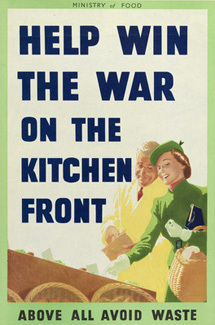
British poster, 1940 (Imperial War Museum)
Tea—that most British of staples—was added to the list on July 8, 1940 (2 oz per week)—as well as margarine (6 oz per week) and fats (2 oz per week).
To deal with continuing sugar shortages, cakes were not allowed to be iced (frosted) as of August 5, 1940. Jam, marmalade, syrup, and treacle (molasses) were rationed as of March 17, 1941 (8 oz per month), and sweets and chocolates on July 26, 1942 (8 oz per 4 weeks).
Cheese was added to rationing on May 5, 1941 (1 oz per week), and milk and eggs were allocated starting May 28, 1941. Since eggs were so scarce, most people didn’t receive their allocated one egg per week. When US Lend-Lease supplies began arriving in Britain, people began receiving a tin of skim milk powder each month (December 1941) and a tin of dried eggs every two months (June 1942).
The Ministry of Food introduced a point system on December 1, 1941. At first this applied to canned meat, fish, and beans, but later included rice, canned fruit, cereals, and biscuits (cookies).
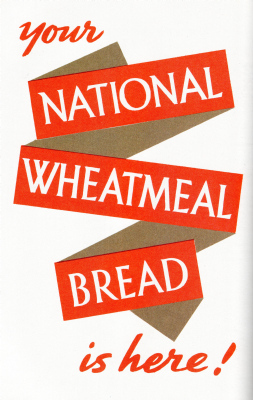
British ad for National Wheatmeal Loaf, WWII
Bread was never rationed during the war, but the sale of white bread was banned and an unpopular National Wheatmeal Loaf of wheat and potato flour was sold instead.

British Dig for Victory poster, promoting home gardening, WWII
Fruits and vegetables were never rationed, but most were scarce, including onions, tomatoes, and oranges—onions were even used as raffle prizes! Lemons and bananas were completely unavailable. To supplement their rations, people were encouraged to plant “Dig for Victory” gardens and to raise chickens and pigs.

British poster, WWII
Because potatoes and carrots were unrationed and plentiful, the government promoted their use, and they appear in most wartime recipes, substituting for other foodstuffs.

“Potato Pete” poster, British, WWII (Imperial War Museum)
Overall, the rationing system in Britain provided a bland and meager diet, but it ensured that everyone had enough to eat and promoted a “we’re all in this together” mentality.
Which part of food rationing would have been most difficult for you?
The post Food Rationing in Britain in World War II first appeared on Sarah Sundin.Today in World War II History—January 8, 1940 & 1945

British ration book for a child, WWII (National Archives UK)
85 Years Ago—Jan. 8, 1940: Britain begins food rationing—each person to receive 4 oz of bacon or ham, 4 oz of butter, and 12 oz of sugar weekly (Read more: “Rationing in Britain in World War II”).
Vera Lynn’s song “We’ll Meet Again” appears on the British music charts.
80 Years Ago—Jan. 8, 1945: Germans demolish floodgates on the Ruhr River, flooding the area west of Cologne.
Japanese execute Filipino resistance leader Col. Pastor Martelino.
In Placer County, CA, the home of a recently returned Japanese-American family is attacked (shed burned and shots fired), the first of 30 similar incidents on the West Coast.
The post Today in World War II History—January 8, 1940 & 1945 first appeared on Sarah Sundin.January 7, 2025
Today in World War II History—January 7, 1940 & 1945

Finnish troops inspecting destroyed Soviet vehicles, Finland, 17 Jan 1940 (US Library of Congress)
85 Years Ago—Jan. 7, 1940: Battle of Raate Road ends in a Finnish victory; over 10,000 have been killed in the Soviet 44th Division.
In US, “Gene Autry’s Melody Ranch” premieres on CBS radio and runs through 1956.
80 Years Ago—Jan. 7, 1945: German Navy begins evacuating troops trapped in Lithuania by the Soviet advance.
Off Manila Bay, US destroyers Charles Ausburne, Braine, Russell, and Shaw sink Japanese destroyer Hinoki in the last surface naval engagement of the Pacific war.
The post Today in World War II History—January 7, 1940 & 1945 first appeared on Sarah Sundin.January 6, 2025
Today in World War II History—January 6, 1940 & 1945

WAVES Yeoman 3rd Class Margaret Jean Fusco photographing friends by King Kamehameha’s statue in Honolulu, US Territory of Hawaii, spring 1945 (US National Archives: 80-G-K-5568)
85 Years Ago—Jan. 6, 1940: Britain declares German ships may not use Norwegian waters; Sweden and Norway deny a British request to operate in their waters.
Norway and Sweden forbid Allied troops from crossing their territory to aid Finland.
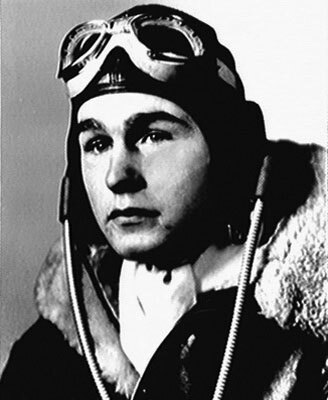
US Navy pilot Lt. George H.W. Bush, WWII (US Navy photo)
80 Years Ago—Jan. 6, 1945: Edith Frank, mother of Anne, dies in Auschwitz.
Future president Lt. (j.g.) George H.W. Bush marries Barbara Pierce in Rye, NY, a few weeks after his return from the Pacific.
First contingent of WAVES arrives in Hawaii; 4,000 will serve there.
The post Today in World War II History—January 6, 1940 & 1945 first appeared on Sarah Sundin.January 5, 2025
Today in World War II History—January 5, 1940 & 1945

Poster recruiting Swedish volunteers to aid Finland—“Finland’s Cause is Our Cause.”
85 Years Ago—Jan. 5, 1940: In the Battle of Suomussalmi, Finnish troops encircle 18,000 Soviet troops north of Lake Ladoga.
The first Swedish volunteers arrive in Finland to help in the war against the Soviet Union.
Britain announces no one with a German passport, including Jews, can enter Palestine.
FM radio is demonstrated for the first time in the US.

Heavy cruiser USS Louisville under kamikaze attack, 6 Jan 1945 (US National Archives: 80-G-363217)
80 Years Ago—Jan. 5, 1945: As Allied invasion force approaches Lingayen Gulf on Luzon, kamikazes damage heavy cruisers USS Louisville and HMAS Australia, destroyers USS Helm and HMAS Arunta, escort carriers USS Manila Bay and USS Savo Island, and destroyer escort USS Stafford (54 killed on all ships).
The post Today in World War II History—January 5, 1940 & 1945 first appeared on Sarah Sundin.January 4, 2025
Today in World War II History—January 4, 1940 & 1945

Adm. Lord Louis Mountbatten observing Mandalay from a distance aboard a WC command car, Burma, 13-18 Jan 1945 (Imperial War Museum: SE 1403)
85 Years Ago—Jan. 4, 1940: Britain requisitions all merchant ships for the war effort.
80 Years Ago—Jan. 4, 1945: In Burma, British secure Akyab Island; Burma is now secured from Akyab to Mandalay and north of the Irrawaddy River.
The post Today in World War II History—January 4, 1940 & 1945 first appeared on Sarah Sundin.January 3, 2025
Today in World War II History—January 3, 1940 & 1945

Men of US 290th Infantry Regiment, 75th Infantry Division near Amonines, Belgium, 4 Jan 1945 (US Army photo)
85 Years Ago—Jan. 3, 1940: Finland bans smorgasbords to conserve food.
President Roosevelt calls for $1.8 billion in defense appropriations.
80 Years Ago—Jan. 3, 1945: In the Battle of the Bulge, US First Army begins an offensive on the north flank of the Bulge.
Congress creates the Committee on Un-American Activities, replacing the Special Committee on Un-American Activities (Dies Committee) established in 1938.
US Navy organizes a hunter-killer group (escort carrier and destroyers/destroyer escorts) to intercept a U-boat believed to be bound for New York with V-weapons (a false report).
The post Today in World War II History—January 3, 1940 & 1945 first appeared on Sarah Sundin.January 2, 2025
Today in World War II History—January 2, 1940 & 1945
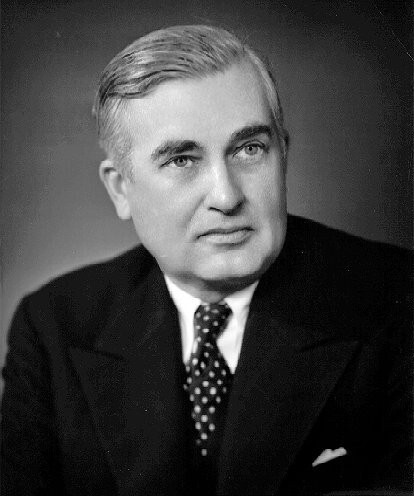
Charles Edison, 1945 (US National Park Service photo)
85 Years Ago—Jan. 2, 1940: Charles Edison (son of Thomas) becomes US Secretary of the Navy.
In German-occupied Czechoslovakia, Gestapo arrests journalists and former army officers.

Adm. Sir Bertram Ramsay, Allied Naval Commander-in-Chief of the Expeditionary Forces, at his London Headquarters at Norfolk House, 1944 (Imperial War Museum: A 23443)
80 Years Ago—Jan. 2, 1945: Adm. Sir Bertram Ramsay, Allied Naval Commander in Chief, Expeditionary Force, dies in a plane crash at Toussus-le-Noble, France.
Japanese-Americans are no longer excluded from the West Coast, but with exceptions.
The post Today in World War II History—January 2, 1940 & 1945 first appeared on Sarah Sundin.


